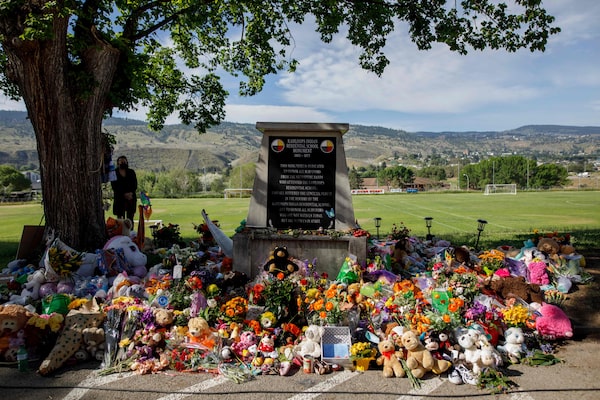
A makeshift memorial honoring the 215 children whose remains have been discovered buried near the facility surrounds a monument outside the former Kamloops Indian Residential School in Kamloops, British Columbia, Canada, on June 2, 2021.COLE BURSTON/AFP/Getty Images
In theory, it doesn’t matter that the Senate took up Bill C-15 the same week that the Tk’emlúps te Secwépemc First Nation announced they had located the remains of 215 First Nations children at the Kamloops Indian Residential School. In reality, it means everything.
C-15 will become law in the shadow of stark, new proof that Canada has horribly abused its Indigenous population, decade after decade. Some Canadians will resist the increased Indigenous autonomy that will almost certainly flow from the bill. But for anyone who seeks genuine reconciliation, there is no other way.
“Canada can’t afford to be a country that denies Indigenous human rights,” said Aimée Craft, a professor of Indigenous law at University of Ottawa. “Canada needs to recognize Indigenous sovereignty. We have no choice.”
Once C-15 becomes law, the federal government will, in consultation with Indigenous Canadians, have two years to draw up an action plan to incorporate the United Nations Declaration on the Rights of Indigenous Peoples, or UNDRIP, into Canadian law.
Two elements in that declaration stand out. One is Article 3: “Indigenous peoples have the right to self-determination. By virtue of that right they freely determine their political status and freely pursue their economic, social and cultural development.”
Other articles refer to the duty for governments to seek to obtain “their free, prior and informed consent” before taking actions that could affect Indigenous communities.
While Justice Minister David Lametti insists that “free, prior and informed consent” does not confer the power of veto to Indigenous Canadians over, for example, any proposed resource development on lands they claim, others fear it does.
The Conservatives do not believe UNDRIP should be imported into Canadian law without first “coming to a common understanding of what free, prior and informed consent actually means,” said Jamie Schmale, the Conservative critic for Crown-Indigenous relations, during debate in the House.
But even if the new law does extend some form of veto over actions that impinge on Indigenous autonomy – such as approving a mine on land claimed by a First Nation – “the idea of a veto is only uncomfortable when people are giving up their own veto,” Prof. Craft says.
That said, things are bound to get messy. Securing consent within any given First Nation can be difficult. Multiply that by more than 630 First Nations across Canada, add in the rights and interests of Inuit and Métis Canadians, take into account the role of provincial governments, both as sovereign actors and as providers of health care, education and other social services, factor in private-sector interests and the interests of non-Indigenous Canadians, and you are looking at years and years of lawyers and courts, lawyers and courts.
But the debate over Indigenous rights will not only take place in courtrooms. It will take place on reserves and in communities with large Indigenous populations. It will take place in Parliament, but also on the street and in classrooms and in our own homes. And it will take place in the midst of what must be a concerted effort to uncover the bodies of the thousands of children buried on the grounds of residential schools.
That debate could lead, for Indigenous Canadians, to the recognition of “an inherent right to self-government within a sovereign state’s legal framework,” Bloc Québécois MP Marilène Gill said in the House. “There is autonomy, but within the legal framework of a sovereign state, within Canada.”
Former NDP MP Romeo Saganash, who sponsored two very similar private member’s bills in previous Parliaments, sees the new legislation as a pragmatic attempt to replace the incoherent and contradictory patchwork of law surrounding relations between Indigenous Canadians and the Crown with something more coherent and consistent.
“I’m at a loss to understand why anyone would defend such an unjust and uncertain status quo,” he wrote to The Globe and Mail last week.
The new law could fail, rendered toothless by governments that jealously protect their jurisdiction, by courts unwilling to recognize greater Indigenous independence. But if it succeeds, incorporating UNDRIP into Canadian law could transform the lives of Indigenous Canadians within Canada.
“It is really, fundamentally, a self-determination model of Indigenous rights,” said Cherie Metcalf, professor of law at Queen’s University. “It’s not necessarily going to be a straightforward path, but I do think it’s the right one.”
Keep your Opinions sharp and informed. Get the Opinion newsletter. Sign up today.
 John Ibbitson
John Ibbitson